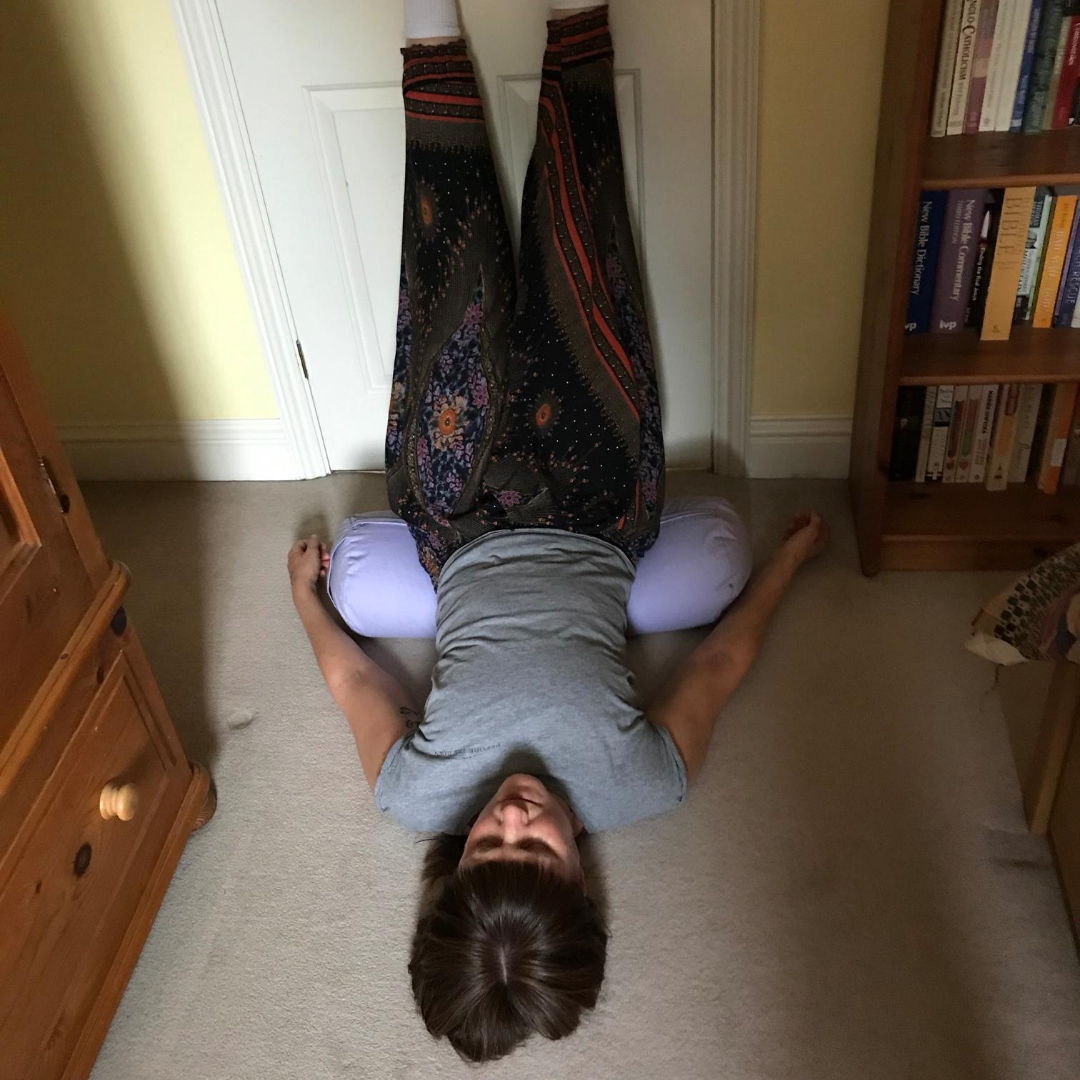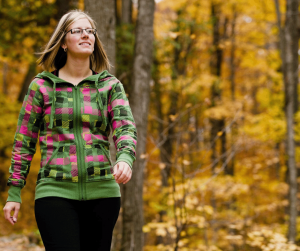Turning yourself upside down is surprisingly calming.
Any mention of handstands or headstands at a Yoga class used to make my stomach clench with worry. Like most people, I generally feel safest with my feet firmly on the ground. The mere idea of turning upside down, with a balance challenge thrown in, woke up all my inner inadequacies.
Yet weirdly, when my teacher actually supported me into an upside down pose, I often felt exhilarated and unexpectedly calm. There are good reasons why the guru B K S Iyengar described headstand and shoulderstand as the king and queen of Yoga poses. Turning ourselves upside down can have remarkable benefits for both mind and body[i].
Head below the Heart
I don’t teach handstands or headstands in my Yin and Restorative Yoga classes, but I do include at least one inversion in almost every session. A inversion in Yoga is any position where the head is below the heart. So this can be a gentle supported shoulderstand or legs up the wall, as well as downward facing dog or a standing forward bend. All these poses are good for the circulation, the lymphatic system and the nervous system. They can also calm and settle the mind[ii].
Inversions, Blood Pressure and Feeling Calm
Turning yourself upside down has interesting effects on your blood pressure and vagus nerve. This is because our bodies are brilliant at regulating themselves. We have special pressure detectors called baroreceptors in our aortic and carotid arteries in the chest. When we turn upside down, the blood pressure in the area above the heart initially increases due to gravity. More blood is flowing towards the head.
But our clever baroreceptors detect the rise in blood pressure and work to correct it. They do this by causing a parasympathetic response in the nervous system. This decreases the heart rate and relaxes the blood vessel walls. This has the effect of decreasing blood pressure. It also makes you feel calm[iii].
Stillness and Relaxation
So turning upside down can initially cause feelings of tension, due to both the mental challenge of the position and the rush of blood towards the head. But after a short time the parasympathetic response will bring about a lowering of blood pressure and a sense of stillness and relaxation. It is thought that this stimulation of the baroreceptors helps strengthen your ability to regulate your blood pressure. As with all Yoga poses, the more often you practice inversions, the more your body and mind will benefit.
Take Care of Yourself
However you should not begin to practice demanding inversions such as headstands if you have uncontrolled high blood pressure. And you should always build up your practice slowly and carefully, following the guidance of a qualified teacher and paying close attention to the needs of your own body.
Benefits of Inverted Positions
Raising your legs above your head in a supported position can be very relaxing. I love the legs up the wall position, where you can get all the benefits of a gentle inversion without putting pressure on the neck or worrying about balance. Our legs and lower spine work very hard all day supporting our weight. Lying down with your legs up the wall releases this pressure on the lower body. It is especially helpful for varicose veins, swollen ankles and heavy legs as gravity helps fluid drain out of the legs.
B K S Iyengar lists so many benefits for inverted positions. Turning yourself upside down is helpful for insomnia, thyroid function, asthma, constipation, colds, haemorrhoids and hernias. It can alleviate urinary disorders and uterine prolapse, and also helps regulate menstrual flow if done regularly between periods. The mind and body are integrated and calmed[iv].
Seeing the World from a Different Angle
When we turn ourselves upside down, we literally see the world from a new angle. Settling and resting into a safe inverted pose can be an opportunity for reflection and meditation. It can help us let go of worries and start afresh.
Safety Considerations and Cautions
You should avoid inverted Yoga poses, especially demanding ones like headstand or full shoulderstand if you have uncontrolled high blood pressure, any problems with your neck or upper spine, headache or migraine. Most yogis recommend avoiding inversions during a menstrual period. If you want to learn headstand or handstand, always seek the help of a qualified Yoga instructor. These poses can be dangerous without proper support and supervision.
Today’s Calming Activity – Legs Up the Wall
Relaxing with your legs supported against a wall or door is an easy and accessible way to enjoy the benefits of inversion. But only try this today if you are feeling well, and come out of the pose if it does not feel right for you. If you have high blood pressure, migraine, neck problems or you are on your period, use this opportunity to rest lying down in any comfortable position instead.
Find a wall and sit sideways onto the wall with one buttock pressing right up against the base of the wall. Then rotate yourself round so that you are lying on the floor at right angles to the wall, with your legs supported up against the wall. If there is a big gap between your bottom and the base of the wall, come down carefully, move your buttock closer to the wall, and try again.
Once you are here and feeling ok, you can try placing a cushion or folded blanket under your bottom to raise your hips a little higher, if you wish.
Make sure you are feeling comfortable here. Check that your lower back and neck feel ok. Avoid turning your neck to one side. Then place an eye pillow over your eyes and relax.
If it feels good, you can stay here for up to twenty minutes or more.
This is a great pose to do before bedtime if you have trouble getting off to sleep.
Come out of the position slowly and carefully the same way you went in. Lie down on your side for at least five breaths before slowly getting up.
You should feel calm and relaxed.
Here is a link to a short video of me demonstrating how to get into the legs up the wall position. I hope you find it helpful.
Thanks for reading this blog post. I am writing a series of 31 blogs every day this August. I plan to publish them later in the year as a book entitled, ‘Finding Your Calm Space – 31 Ways to Find Calm in a Crazy World’.
I’m Karen. I am a Yoga teacher, Reflexologist and busy mum of seven. I live with my family in Billericay, Essex, UK. In the past I have worked as a Midwife, Health Visitor, Baby Signing teacher and Tax Inspector. I love getting outdoors, swimming in the sea, walking and writing. Helping people relax is one of the things I do best.
You can learn more about my Yoga classes and Reflexology at my website www.thecalmspace.co.uk
[i] https://www.yogajournal.com/practice/the-importance-of-shoulderstand-and-headstand#:~:text=By%20referring%20to%20Sirsasana%20(Headstand,and%20they%20are%20a%20pair.
[ii] https://www.ekhartyoga.com/articles/practice/all-about-yoga-inversions#:~:text=Inversions%20are%20yoga%20poses%20where,benefits%20of%20being%20upside%20down.
[iii] https://study.com/academy/lesson/regulation-of-blood-pressure-short-term-regulation-baroreceptors.html#:~:text=monitored%20by%20baroreceptors.-,Baroreceptors%20are%20special%20receptors%20that%20detect%20changes%20in%20your%20blood,increased%20activity%20within%20the%20baroreceptors.
[iv] https://www.amazon.co.uk/Iyengar-Holistic-Health-Step-Step/dp/1409343472/ref=sr_1_1_sspa?crid=GA539GZZW0EA&dchild=1&keywords=iyengar+yoga+books&qid=1596962281&sprefix=iyengar%2Caps%2C144&sr=8-1-spons&psc=1&spLa=ZW5jcnlwdGVkUXVhbGlmaWVyPUExNkRMNlk3MDUxRllSJmVuY3J5cHRlZElkPUEwMzU0MzIwMk8wTDRMU1k4RTRTMCZlbmNyeXB0ZWRBZElkPUEwNjI3Mjg4MlAzS0wyV1pGNlIyMCZ3aWRnZXROYW1lPXNwX2F0ZiZhY3Rpb249Y2xpY2tSZWRpcmVjdCZkb05vdExvZ0NsaWNrPXRydWU=




